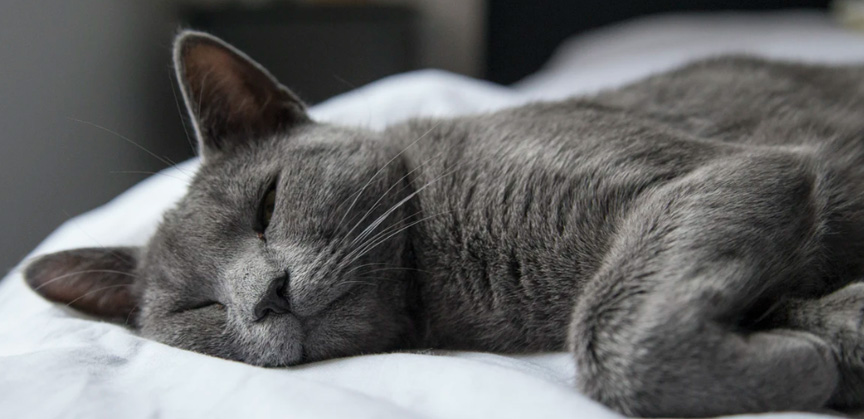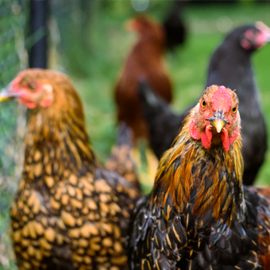 There are plenty of cat breeds out there to choose from – so many that you might not even know where to start. Not only do you have to decide whether to adopt a rescue, or go through a breeder, you've also got to decide what kind of temperament you want your cat to have, and what you want it to look like. You've also got to think about things like downsides, and what it takes to look after them. Let's take a look at one cat breed, in particular, the Russian Blue cat, and see if they're a match made in heaven with your personal cat needs.
There are plenty of cat breeds out there to choose from – so many that you might not even know where to start. Not only do you have to decide whether to adopt a rescue, or go through a breeder, you've also got to decide what kind of temperament you want your cat to have, and what you want it to look like. You've also got to think about things like downsides, and what it takes to look after them. Let's take a look at one cat breed, in particular, the Russian Blue cat, and see if they're a match made in heaven with your personal cat needs.
Russian Blue Cat Basics
So, what is a Russian Blue cat, then? Interestingly, the Russian Blue cat is actually part of a group of unique looking cats. This means that they're directly related to the Korat cat breed, which hails from Thailand, and British Blue cat, and the Chartreux, which originates in France. Despite all of their cousins, though, the Russian Blue cat has its own set of unique character traits.
One of the biggest things that make Russian Blue cats stand out from the pack is their eyes. You'll be able to easily notice them in the dark because their eyes are bright green. They also tend to be slightly skinnier than some of their close relatives, and their face is a different shape as well. With other breeds that are closely related to them, you'll find a rounder face. If you're looking for a kitty that's going to hang around for a while, this could be the one – Russian Blue cats can live up to 20 years, sometimes even longer. They have a lot of nicknames, including Maltese, Foreign Blues, and Archangel Blues.
Origin of Russian Blue Cats
If you are here to know the true origin of the Russian Blue cat, you might leave disappointed – because nobody actually knows its true origin. This is because they are naturally occurring, so it's virtually impossible to trace them back to where they first began. However, there is a really high chance that they can be traced back to Russia. There are two different theories about their origin. The first is that they were kept as prized pets by Czars, while others speculate that, based on the fact that they are naturally occurring, they were once wild. However, they might have been quickly targeted and hunted for their fur, which is dense and thick, and in Russia much sought-after.
This thick coat of fur helped them survive the harsh, unforgiving Russian winters. However, this doesn’t mean that they can’t live in temperament climates, too, and over time they have adapted to various locations.
Either way, one of the first locations that the Russian Blue cat can be pinned at is Arkhangelsk, a port city and one of their namesakes. It is here that they were invited onboard sailors ships as ship cats, which is how they eventually made their way to other parts of the world, most notably Northern Europe and Great Britain.
History of the Russian Blue Cat
As you might have already guessed, with their bright green eyes and aesthetically pleasing fur, once Russian Blue cats made an appearance in the U.K., they quickly proved to be popular. For almost 150 years, the Crystal Palace has been home to one of the world’s most esteemed cat shows, and Russian Blue cats have been a solid fixture there ever since they first began. While they might not have been one of the prize-winning breeds, they certainly were much-loved by everyone, largely because of their striking appearance.
Despite their notoriety at the Crystal Palace, it wasn't until this cat breed found its way to America in the early 1900s that it was officially recognized as a cat breed. While the Second World War saw them decline in popularity, small pockets of Russian Blue fans managed to save them and cause a resurgence shortly after. In some European countries, breeders even cross-bred them with Siamese cats to produce desired features, like longer bodies. In the U.K, they have been cross-bred with British Blue cats, for a stockier appearance. Luckily, the Russian Blue breed that you will be able to own today looks very similar to their original appearance.
Physical Appearance
Speaking of appearance, let’s talk about what you can expect your Russian Blue to look like. Apart from the striking green of their eyes that we’ve already talked about, the other defining characteristic is their super dense coat, which is twice as dense as many other cat breeds out there. While from a distance, the Russian Blue might give off the appearance of being blue-gray, it's actually their undercoat that is blue, which is covered by the outer layer, which is silver. Their ears stand up pointed and straight and are usually a shiny silver. You can also get Russian Blues in three different types – white, black, and blue. As you might have already guessed, the blue type is by far the most popular.
Their wedge-like head is markedly smaller than other cat breeds, which makes their mouth smaller as well. This is perhaps why their eyes stand out even more. With a slender body and pink paws, this purebred Russian cat breed comes with all the attributes you could want in a cat. They tend to look either curious or friendly, and never really grumpy.
You also don’t need to worry about the neighbors being woken early in the morning by your hungry cat – Russian Blues are known for being particularly loud cats.
Taking Care of Your Russian Blue Cat
You might think that because the Russian Blue has such a big, thick coat, they’re a pain to clean up after in terms of shedding. However, the opposite is actually true – they don’t really shed at all. This is why it’s not as important with these guys to brush them as other breeds – but we still recommend that you do, so that their coat can stay nice and shiny from the naturally occurring oil in their skin. As we talk about a bit more down below, Russian Blues are known for being very fussy when it comes to keeping up with their appearance. While this means that you won’t need to worry about brushing them too often, you will need to make sure that their litter is cleaned regularly.
Because they're so curious, they might also get themselves into trouble when they didn't mean to. This is why it's worth investing in locks on doors that you don't want them to open or an outdoor cat enclosure, and making sure they can't get into small, tight spaces, where they might get stuck. Because of their somewhat unique personality, which we'll go into more below, it's best to match up the Russian Blue with families that have older kids. However, they're also great if this is your first time having a cat, so they cover a lot of circumstances.
Russian Blue Cat Personality
Are you someone who loves to get into a good routine? Then you're going to have an easy companion in your Russian Blue. This cat breed tends to stick to its own schedule and is pretty quiet, which can sometimes be mistaken for shyness. In fact, Russian Blue owners don't tend to really hear from their kitties unless they're annoyed about something, or hungry. However, it's best not to be fooled by how calm they come across – they can move very quickly when they need to, which can be hazardous if you have things that can be knocked over.
As well as being curious and somewhat shy, Russian Blues are also really good at establishing a firm, long-lasting relationship with their owners. They love those who show them affection and will stay loyal to you forever. In fact, a lot of the time, this cat breed needs more attention than the average kitty – and might feel the pain if you go away for an extended time period. Russian Blues are also big fans of playing around and having a bit of fun, and because they're considered one of the smarter cat breeds, you can also teach them tricks – you can even teach them to fetch.
They try to balance the playfulness with moments of reservation, too, and can be timid when meeting new people, or put in a new environment. They like to keep themselves clean, which is a plus – they are pretty low maintenance when it comes to taking care of them.
Potential Health Issues
If you’re worried about taking on more than you can chew with a cat, you don’t have to here with Russian Blues. This is because, when compared to other cat breeds, they are known for being robust, healthy kittens. They are susceptible to all the usual health issues that many cat breeds face from time to time, including UTIs and bladder stones, but apart from this, they're usually in tip-top shape. The only real issue that you have to think about is obesity.
This is because Russian Blue has a tendency to overeat – they absolutely love to gore themselves, and they’ll always be asking for more, no matter how much you give them. This is why it’s good to limit their daily intake to just what they need, and make sure that they don’t have access to more. It might also be worth talking to your veterinarian about a health food plan if you’re not too confident about this part.
Fun Facts
You might think you know it all at this point when it comes to the Russian Blue, but you may be surprised to learn that there’s always something more to find out. For example, did you know that all Russian Blues have a mouth that looks like it’s smiling all of the time?
Or, did you know that this unique cat breed is said to have been kept in newborn nurseries as a good luck charm to keep evil spirits at bay? Lastly, you might not know that there is a conspiracy theory doing the rounds that Tom, of Tom and Jerry, is a Russian Blue. Who knew?













